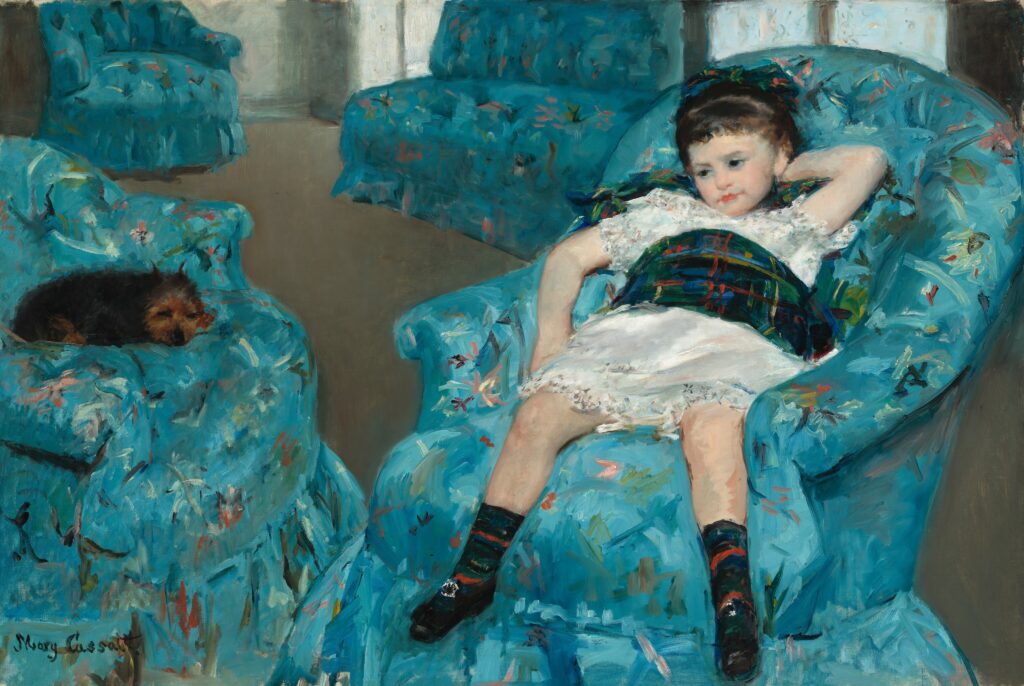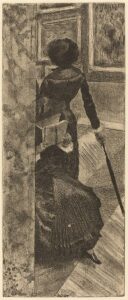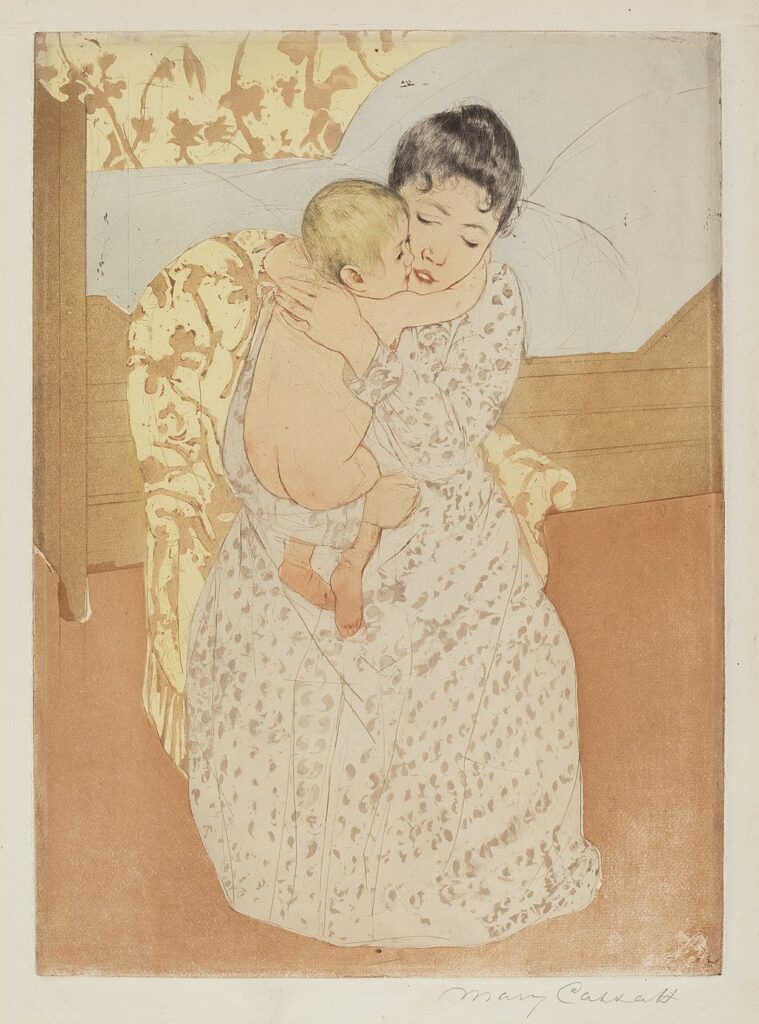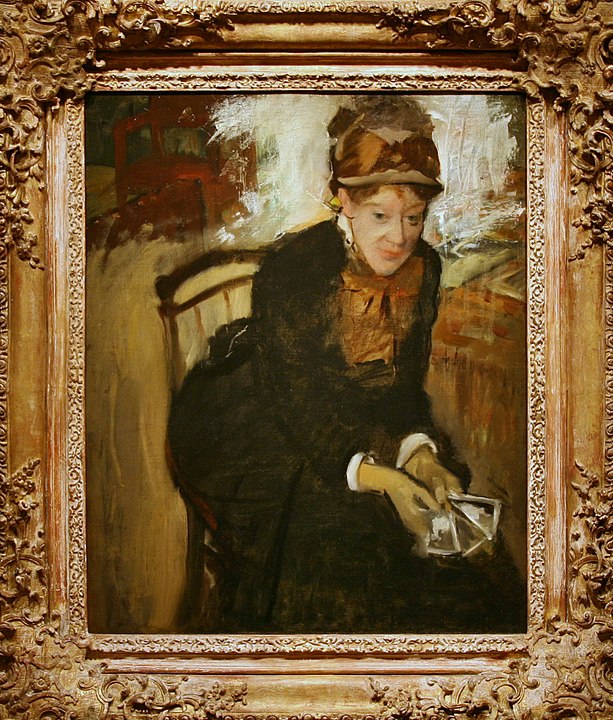Mary Cassatt wanted to become a great painter. She grew up in Pennsylvania with parents who took their family to Europe for school, where she became fluent in German and French and developed an interest in European art. When she was fifteen years old, Cassatt knew she would become an artist one day, and enrolled in the Pennsylvania Academy of Fine Arts to learn more about painting and increase her overall skill level. Cassatt now felt she needed to be challenged as an artist and go to a place where she could learn from the best. She had a taste for Europe before in her life, and she wanted more. Her family was not fully supportive of this decision at the time, with her father going so far as to say he would almost rather see her dead than leave by herself for Europe. She was independent and could not be dissuaded, and she and her mother arrived in Paris in 1965.1
She wanted to learn and test herself in the best environment, and for art and painting, that was Europe, and more specifically, Paris. A lot of the newest art movements began in France, and there were exhibits and competitions for artists all year. She had options to learn from a mentor and did so for a couple of years, but decided for herself that observing paintings in museums and making her own notes would be better for herself. She wanted to learn her own way and go her own path, later saying, “One does not need to follow the lessons of an instructor.”2
She had to leave France, due to the Franco-Prussian War in 1870, and she traveled all over Europe for many years, stopping in Italy, Spain, and Belgium, before she came back to Paris in 1873. She had a desire to change her style, as a lot had changed in France since she had left. Her work, which she submitted to the Salon, kept getting rejected for various reasons, like being too bright, which was often a criticism of impressionism and of the new art movements of the time.3 France was the epicenter for new art movements from the 1850s to the 1910s, before other European countries and the United States started to catch up and create their own unique styles and art movements. But every big and influential movement usually had its roots in France. Impressionism was the newest of these to be introduced and to evolve into an art genre. Impressionism was a movement within art that was mainly about painting there environment and doing so in a way that would be done quickly but also done to look what nature and people actually looked like and not to be exaggerated too much. Impressionists also did painted on the spot, and did not change it afterwards as often. They would do a lot of painting outside, in front of what they were painting, and do most of it right there. This intrigued Cassatt, and she would stare at the impressionist paintings hanging in the gallery windows when she got back to Paris, and one of them in particular was by Edgar Degas. He was one of the more prominent and forthcoming impressionist artists of the time, and is remembered as one of the most influential artists in history. She would admire these impressionist paintings and try to learn their techniques to incorporate them into her own style.4
Cassatt and Degas met in 1877, just two years before her big break into the art scene. They had met and developed an acquaintanceship, but their relationship would grow further when Degas invited her to the Fourth Impressionist Exhibition held in 1879 in Paris. She was one of many new artists that Degas invited to participate, so he could grow the exhibit and expand the Impressionist movement to all of France.5 This was when their relationship went from a simple friendship to that of a mentorship. Degas would help Cassatt with many paintings, most notably on arguably Cassatt’s most famous painting, The Little Girl in a Blue Armchair. It was found decades later to have brushstrokes in the background that were not in Cassatt’s style but in Degas.’6

She was also invited by Degas to join a group known as the Independents. They were a new group formed by many new impressionist painters trying to break free from the artist hierarchy in France, and they included Degas as well as other very influential French artists like Claude Monet and Pierre-Auguste Renoir. Cassatt accepted Degas’ invitation, as it helped in getting her involved with the Impressionists as well as the impressionist exhibit coming up, which was a big opportunity for her to show off her new work. However, it was a risky decision to join the Independents, and that was because the traditional art establishment in France would no longer look at or accept her work, due to her joining the group. She committed herself to impressionism, and her artwork was no longer for conventions or events that were more traditional and still stuck with the established art styles and movements. It worked out greatly for her, but it was not a guaranteed success when she made the decision.7

Degas mentored Cassatt to an extent, but Cassatt also helped him when they worked together. She was featured in many of his paintings, including Cassatt at the Louvre and Mary Cassatt. The former was a painting of Cassatt and another woman admiring paintings at the Louvre, and she modeled for that painting. She also modeled for Mary Cassatt, which was essentially a self-portrait of her holding cards in a game. They would often get into friendly arguments while brainstorming and discussing their art, and they were not always one and the same on every topic, especially on Degas’s views on women in art and other groups of people. But they were friends nonetheless and each helped each other in part at different stages of their careers.8
Degas opened a journal that was only for black-and-white printmaking and invited only a few artists to participate in it. Mary Cassatt was one of the first names he reached out to to be a part of this project, and she delightfully accepted. He would mentor all the artists on how to learn printmaking, which Cassatt had not done before. She really grew to love the art of printmaking and soft-ground etching. The journal was never finished, so it was never officially released, but it had a significant impact on Cassatt for the rest of her career. She really enjoyed her time learning to printmake and would get better at it as the years went by. It would soon become one of her main skills in artistry, which she enjoyed doing for the latter part of her career. She took inspiration from Japanese art and printmaking and incorporated it into her own style.9

Cassatt was one of the first major women to have success in art. She was a modern woman in a world where women had to be aligned with a rich and powerful man to get to the top, and even then they were not treated the same when they got there. She was an early feminist from her time back in America as a teenager and was extremely independent. When she was at the Pennsylvania Academy for Fine Arts, she, along with other female students, would be harrassed by male students. It was a demeaning experience, but she and her classmates persevered, and many traveled to Europe to continue their studies and practice their art skills in a more professional environment. Her paintings were usually female-oriented, with women living their lives or doing daily tasks that were not always appreciated. She didn’t take the traditional route to success for a woman, as she never married in her entire life, which showed in her paintings and printmaking, but she still found success nonetheless.10
Once the 1900s started, the relationship between Cassatt and Degas deteriorated, but not in a necessarily bad way. They drifted apart in their art and in their relationship. Degas had moved away from impressionism as new art movements and techniques came along, while Cassatt focused more and more on printmaking and other media of art than painting. She was already successful and reputable in France at the time. She had made a career for herself in a world that made it harder for her to do so. Degas passed away in 1917, which caused great sadness for Cassatt.11 She later passed away in 1926 after having stopped working for years due to health issues.
- Nancy Mowll Mathews, Mary Cassatt: A Life (New Haven, Connecticut: Yale University Press, 1998), 11, 15, 26-29. ↵
- Steven C. Munson, “Mary Cassatt, Modern Painter,” Commentary 108, no. 2 (September 1, 1999): 55. ↵
- Steven C. Munson, “Mary Cassatt, Modern Painter,” Commentary 108, no. 2 (September 1, 1999): 55. ↵
- Steven C. Munson, “Mary Cassatt, Modern Painter,” Commentary 108, no. 2 (September 1, 1999): 55. ↵
- Steven C. Munson, “Mary Cassatt, Modern Painter,” Commentary 108, no. 2 (September 1, 1999): 55. ↵
- National Gallery of Art, “Degas/Cassatt,” Degas/Cassatt (Booz Allen Hamilton Inc, The Robert and Mercedes Eichholz Foundation, Federal Council on the Arts and the Humanities, December 16, 2013), https://www.nga.gov/features/degas-cassatt.html. ↵
- Steven C. Munson, “Mary Cassatt, Modern Painter,” Commentary 108, no. 2 (September 1, 1999): 55. ↵
- Steven C. Munson, “Mary Cassatt, Modern Painter,” Commentary 108, no. 2 (September 1, 1999): 55. ↵
- National Gallery of Art, “Degas/Cassatt,” Degas/Cassatt (Booz Allen Hamilton Inc, The Robert and Mercedes Eichholz Foundation, Federal Council on the Arts and the Humanities, December 16, 2013), https://www.nga.gov/features/degas-cassatt.html. ↵
- Steven C. Munson, “Mary Cassatt, Modern Painter,” Commentary 108, no. 2 (September 1, 1999): 55. ↵
- National Gallery of Art, “Degas/Cassatt,” Degas/Cassatt (Booz Allen Hamilton Inc, The Robert and Mercedes Eichholz Foundation, Federal Council on the Arts and the Humanities, December 16, 2013), https://www.nga.gov/features/degas-cassatt.html ↵



2 comments
Andrew Ponce
Articles such as this are very easily appreciated. And for the right reason. This article has dug up a topic in American history that many people may not know about, but ought to. The story of Mary Cassat is so fascinating and rich in benchmarks. Such as the impactful role she played in women’s art. Her story, along with her artwork are worth knowing on their own. This article simply managed to place the reader in a better position to understand and appreciate her story and work. Outstanding job!
Gaitan Martinez
With modern day society, we are trying to shine more light on hidden figures in the past. The story of Mary Cassatt, was very intriguing and not to mention her artwork was truly something unique. I am completely surprised to find out that she was the first major women to succeed in art, and the article elaborates how in her time, women would only gain recognition through their rich husbands.